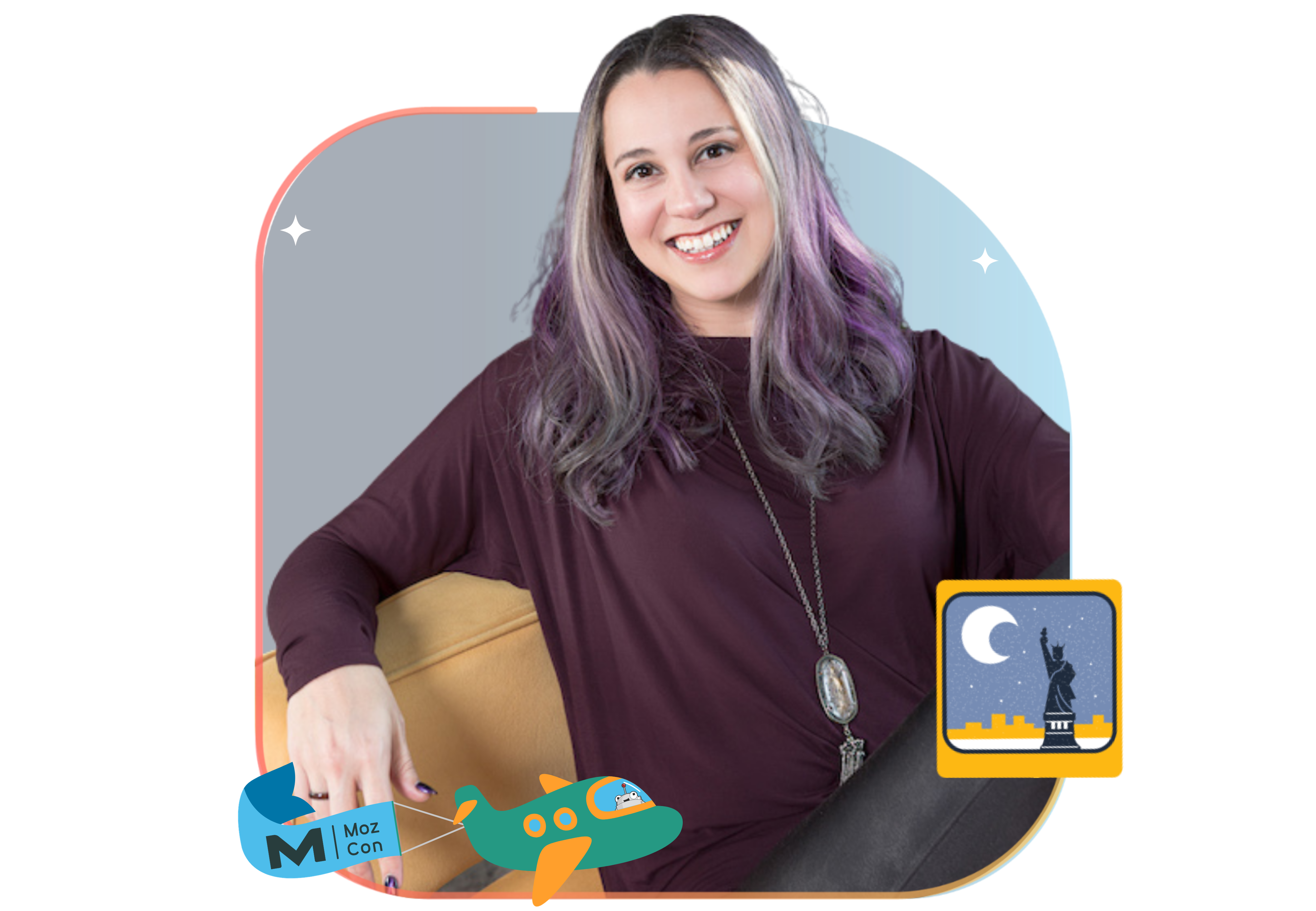Last week, we hosted the first MozCon New York, and it was a success. Ten incredible speakers shared actionable talks on AI search, brand visibility, and new SEO strategies to improve performance.
PS: MozCon is returning in 2026! We’re headed to New York on July 14, 2026, and London on November 13, 2026.
Join the waitlist to get access to Super Early Bird pricing when tickets go live!
1. GEO, AEO, LLMO: Separating fact from fiction & how to win AI search – Lily Ray

Lily explained how most so-called “new” strategies are actually rooted in existing SEO best practices.
Key takeaways:
- LLMs still rely on search to function
GPT-5 and other models use real-time data from traditional search engines. Without content from SERPs to ground responses, they fail or hallucinate.
- Your brand must show up in trusted third-party sources
LLMs heavily cite Wikipedia, Reddit, YouTube, and niche sites. Earning citations in those environments is now core to AI search visibility.
- Optimize for branded questions and reputation signals
Brands should create clear, accurate answers for every possible branded query and control how they’re perceived online.
- Track new AI search metrics, not just clicks and rankings
Lily recommends measuring branded impressions, LLM citations, and share of voice across models. Traditional KPIs don’t capture AI visibility or influence.
Follow Lily Ray on LinkedIn.
2. How to triple organic growth with a multi-platform strategy – Paul Norris

Paul shared how one home appliance brand tripled organic revenue in 90 days by creating content for every platform their audience touches, not just Google.
Key takeaways:
- Search is now just one piece of discovery
Google is sending less traffic to the open web than ever. To stay visible, brands need to create native content across channels where users scroll, stream, search, and shop.
- Repurpose and distribute everywhere
One shoot for Domestic & General produced 26 videos, repackaged into long-form YouTube guides, short social snippets, on-site embeds, and influencer content. It earned 370K+ views and 3.2x revenue growth.
- Short-form content needs search optimization to last
TikTok and YouTube Shorts spike fast and fade unless optimized with hooks, captions, keywords, and native platform cues. Done well, they become evergreen.
Follow Paul Norris on LinkedIn.
The infinite tail: Keyword research for AI – Dr Pete Meyers

Pete argued that AI hasn’t changed the fundamentals of keyword research, it’s just made them more urgent. The long tail is expanding, and marketers need better ways to map and capture it.
Key takeaways:
- We’ve been heading toward natural language for 15+ years
From Hummingbird to BERT and AI Overviews, Google has steadily moved from keywords to meaning. Marketers already have the tools, you just need to apply them in the AI era.
- Track topics instead of keywords
Organize by clusters and measure performance at the topic level. One query now triggers dozens of related questions.
- LLMs expand queries
AI-generated answers often combine results from multiple related searches. Identify all the potential subtopics and intent types (e.g., tutorial, comparison, perspective) tied to a single query to build more complete coverage.
- Create content that AI can’t summarize
Simple, fact-based queries are already answered in AI Overviews or the Knowledge Graph. Competitive advantage now lies in content that’s hard to summarize, such as tutorials, opinions, and nuanced comparisons.
Follow Dr Pete on LinkedIn.
Why every team needs a content engineer, and how to become one – Josh Spilker

Josh made the case for content engineers as the future of content and SEO, explaining how automated systems will define the next wave of growth.
Key takeaways:
- You can’t scale content with a broken system
It’s difficult to scale content creation without a structure that guides how content gets created, updated, and measured. Content engineers fix this by thinking in systems, not individual posts.
- Content engineers drive visibility and velocity
Teams using this approach cut production costs by 50%, doubled their publishing speed, and refreshed content with 40% more impact.
- Great workflows start with clear checkpoints and human review
Josh stressed that automation without oversight leads to chaos. Every system should incorporate brand standards, editorial voice, and manual review to prevent errors and maintain quality.
- Low-code tools make content engineering accessible
With tools like AirOps, Zapier, and Moz API, marketers are building research pipelines, automating policy updates, and scaling refreshes without needing to write a line of code.
Follow Josh Spilker on LinkedIn.
Algorithms can’t save you: How to future-proof your content beyond AI and LLMs – Wil Reynolds

Wil dismantled the obsession with rankings and visibility, arguing that trust is the only real moat against spammy content and shrinking traffic.
Key takeaways:
- Being seen isn’t enough; people have to believe and choose you
Wil showed how his lowest traffic period coincided with his highest conversion quarter. Visibility is useless if your content doesn't earn trust or drive action.
- AI search is easily gamed and lacks credibility
Through original research, Wil demonstrated how brands can rank in AI tools like ChatGPT with minimal changes to their footers and self-written listicles, proving that LLM visibility does not equate to authority.
- Social proof is important for success
AI may surface your content, but people still ask friends, check reviews, and browse social before making a decision. Social is the battleground for trust and brand perception.
- LLMs echo training data, not quality
Wil’s studies found that 59% of AI responses came from training data, not live web pages, giving older, repetitive content an unfair advantage. That’s why brand trust and reputation matter more than spammy SEO tricks.
Follow Wil Reynolds on LinkedIn.
How to diversify your traffic outside of Google SERPs – Misty Larkins

Misty explained how PR can drive demand, branded search, and conversions across platforms.
Key takeaways:
- The SEO safety net is gone
Shrinking SERPs, volatile algorithms, and rising zero-click searches have made Google traffic unreliable. One brand had 66 million impressions with less than 0.5% CTR.
- Branded search is now the most durable moat
61% of brand signals in AI Overviews come from media mentions, not your site. Misty argued that visibility starts when people talk about you, not when you publish content on your site.
- Treat PR like a full-funnel system
Misty broke PR into three phases: earning attention (PR hits), capturing interest (owned content), and converting attention (conversion pages). MU Health grew event registrations by 400% with this model.
- Create PR-worthy content, then distribute it like a publisher
Whether using original research, expert takes, or newsjacking, the goal is to earn media, repurpose it everywhere, and drive branded search.
Follow Misty Larkins on LinkedIn.
Stop losing SEO traffic: AI-powered strategies to detect, fix, & thrive – Sam Torres

Sam showcased the AI-powered system her agency uses to detect traffic drops, diagnose what’s broken, and create a roadmap for success.
Key takeaways:
- Use machine learning to spot issues
Sam shared free Colab notebooks that use models like Isolation Forest and Prophet to pinpoint traffic anomalies down to the day, page, or query cluster without relying on gut instinct.
- Segment your traffic by more than just page or keyword
Clustering by template, SERP type, geography, or device reveals invisible patterns like losing traffic from Google Images or a drop in mobile visibility in one country.
- Prove ROI with test cases and forecasts leadership understands
Instead of “Google did it,” Sam recommends forecasting gains using past case studies, documenting hypotheses, and running small, statistically significant tests to get internal buy-in.
Follow Sam Torres on LinkedIn.
How we increased search visibility by 400% for an enterprise site – Travis Tallent

Travis shared how Brainlabs helped GitHub drive a 400% lift in subfolder traffic by building a system that prioritized intent, scale, and execution.
Key takeaways:
- Audits aren’t a strategy; map the customer journey instead
Most teams get stuck in endless audits and briefs. GitHub used search journey mapping and intent-driven briefs to guide content for every phase of the funnel.
- Prioritize like a product team, not an SEO team
Every SEO initiative was scored using the RISE model (Reach, Intent, Scale, Execution). Only high-impact items were included in the quarterly roadmap.
- Scale by integrating into existing systems
Instead of building new workflows, Brainlabs plugged into GitHub’s Azure DevOps to align with how content and engineering already worked, speeding up approvals and reducing friction.
- Establish a cadence and hold teams accountable
Monthly triage meetings aligned SEO, content, dev, and leadership. Everyone knew when, where, and how to show up, eliminating uncertainty and creating ongoing momentum.
Follow Travis Tallent on LinkedIn.
The new playbook you need for content success post-AI – Chima Mmeje

I explained why the “traffic-first” content model is now outdated and laid out a new system built on demand, trust, and affinity.
Key takeaways:
- Trust and affinity are your biggest levers for long-term growth
Obsessing over rankings and search volume leads to generic content. Instead, prioritize demand-led topics that drive direct traffic, organic mentions, and conversions.
- Become the source of truth
Stand out by creating content that didn’t exist before. Write from first-hand experience and infuse your content with examples that show your thought leadership. This is what earns backlinks and builds long-term authority.
- Use informational content to drive product adoption
Pair informational content with assets that show how to apply the advice and links back to product. It’s a great way to ensure your content earns clicks while driving product adoption.
- Use webinars to capture demand
We generate a significant number of leads from our Moz Practical Marketer webinars. We also use webinars to power our content program and off-site lead gen efforts. I shared the ChatGPT framework I use for creating webinar assets and repurposing the content for lead gen.
Follow Chima Mmeje on LinkedIn.
F*** traffic: How to prioritize conversion over vanity metrics – Bianca Anderson

Bianca challenged SEO’s obsession with traffic and introduced the “Heavy Hitters” framework for finding and protecting the URLs that convert, even when overall traffic drops.
Key takeaways:
- Shift your reporting from traffic to revenue-generating pages
Create a URL-level report that merges GA4 traffic and conversions. Flag any page that consistently drives leads or revenue, even if traffic is low.
- Build a ‘Heavy Hitter Report’ to monitor high-value URLs
Identify your top-performing pages based on conversion, not clicks. Track their visibility monthly so you can act fast when traffic or performance shifts.
- Diagnose traffic drops using a ‘performance dip bucket’ system
Categorize underperforming URLs by root cause: SERP layout changes, cannibalization, algorithm volatility, or intent mismatch. Use this to brief content, UX, or tech teams with clear action items.
- Find your 'brown dwarf stars' and invest in their growth
Use filters in Looker Studio or GA4 to identify pages with high conversion rates but low session counts. Prioritize these for internal linking, content refreshes, or paid promotion.
- Stop sending leadership traffic graphs
Normalize data by page type or conversion rate, and present revenue per URL or per 1,000 sessions. This reframes SEO as a revenue-driving function, not a vanity metric game.
Follow Bianca Anderson on LinkedIn.
What’s happening next for MozCon?
I am thrilled to share that MozCon is returning next year.
MozCon New York — July 14, 2026
MozCon London — November 13, 2026
Join the waitlist to get access to Super Early Bird pricing when tickets go live!





